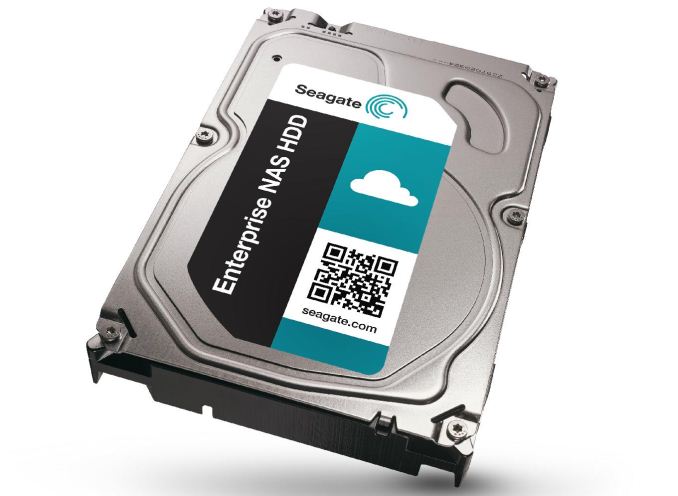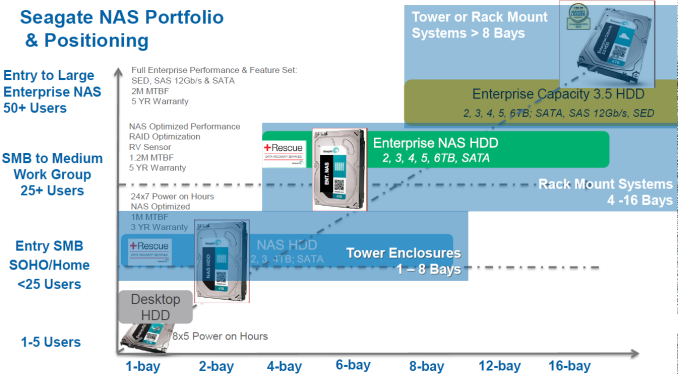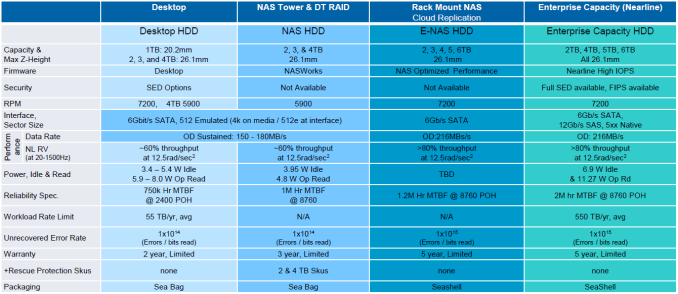Seagate Enterprise NAS HDD: WD Red Pro Gets a Competitor
by Ganesh T S on December 2, 2014 8:00 AM EST- Posted in
- NAS
- Storage
- Seagate
- HDDs
- Enterprise

We have seen this story play out before. Western Digital delineates the hard drive market with a product aimed at a particular niche and Seagate comes in a few months later with a new product line aiming to one-up Western Digital's introduction. The specifications for the Seagate product are a little bit better (SKUs with higher capacity, slightly better performance etc.) - after all, it never pays to be a me-too product in the market without offering something extra to the end users. In the same vein, Seagate is introducing the Enterprise NAS HDD today to go against Western Digital's Red Pro
Similar to the WD Red Pro, the Enterprise NAS HDD is targeted at prosumers / SMB / SME tower and rackmount form factor systems with 8-16 bays (though nothing prevents them from being used in systems with a lower bay count). They are standard 7200 RPM drives with the right balance of features imported from both the NAS HDD as well as Enterprise Capacity lineups.
The key points of differentiation over the WD Red Pro are listed below:
- Higher maximum capacity (6 TB for the Enterprise NAS HDD vs. 4 TB for the Red Pro)
- Larger cache size (128 MB in the Enterprise NAS HDD vs. 64 MB in the WD Red Pro)
- Slightly better MTBF ratings (1.2M for the Enterprise NAS HDD vs. 1M for the Red Pro)
- Bundled data recovery service (not available for WD Red Pro)
Other aspects (such as warranty and URE ratings) are mostly similar. Out of the four points above, the bundled data recovery service is the most interesting. Seagate introduced their data rescue and hardware replacement services last year. In pursuit of differentiation and better integration of this offering with the rest of the company products, the Enterprise NAS HDDs come with this service bundled in the cost. In case of any failure (environmental, accidental or even human error), Seagate handles data recovery as well as replacement of faulty drives (within the warranty limitations). Failed RAID arrays are no exception. With the Enterprise NAS HDDs, this DRS is valid for 3 years starting with the date of purchase. Since the risk of data loss and recovery is borne by Seagate for a reasonable premium, both end-users and resellers are bound to be happy.
Coming back to the rest of the HDD products from Seagate, the table below compares their specifications and differentiating aspects.
Even though it is not specifically mentioned, Seagate indicated that the Enterprise NAS HDDs are designed for workloads up to 180 TB/yr.
For the launch of the Enterprise NAS HDDs, Seagate has teamed up with QNAP. They are also running two webinars to cover any questions that SMB / SME IT decision makers may have regarding the new products.
Pricing information is not available yet, but Seagate indicated that they would be competitive with the WD Red Pro at similar capacity points (with a reasonable premium for the additional data recovery service).
Source: Seagate












22 Comments
View All Comments
Ditiris - Tuesday, December 2, 2014 - link
Some important points since you're directly comparing to the WD Red line... The WD Red Pro drives come with a 5-year warranty, and do indeed top out at 4 TB, for the moment. The WD Red line comes with a 3-year warranty, and includes drives up to 6 TB.Considering the Backblaze failure rate data, Seagate had better steeply discount their products if they want people to consider them over HGST or WD drives.
takeshi7 - Tuesday, December 2, 2014 - link
At least the Seagate drives come bundled with a data recovery service if they fail. WD doesn't offer anything like that.Black Obsidian - Tuesday, December 2, 2014 - link
With an annual failure rate 2-3x that of WD (and 10x that of Hitachi), Seagate buyers are significantly more likely to NEED that data recovery service, too. So it's not like the bundled software is a kind an unnecessary gift from Seagate to its customers.takeshi7 - Tuesday, December 2, 2014 - link
If your only source is that Backblaze study, you should take it with a grain of salt. This study by a major French electronics retailer doesn't support that conclusion.http://www.hardware.fr/articles/893-6/disques-durs...
Samus - Tuesday, December 2, 2014 - link
Although I do appriciate the backblaze study, they make it CLEAR their failure rates for all the drives ranked are for a SPECIFIC application, one that none of the drives are designed for (these are consumer drives running in a cold-storage scenerio among other drives in RAID.) Almost none of those drives have firmware that supports staggared spinup, vibration monitoring, harmonic balancing, differential queuing, and so on.To the point: Seagate consumer drives since the 7200.10-12 up to the Cuda' XT have very aggressive head parking (called load cycles) and they are rated at 250,000-500,000 load/unloads. I've seen drives rack up 90,000+ load/unloads in months if you use them for heavy access (seeding torrents.) NAS\RAID drives have firmware that often completely disables head parking (smart powersaving parameter 0xC1:255)
The reason the Hitachi drives do so well in the Backblaze study is because Hitachi never even implemented the SMART 0xC1 command.
The reason WD drives do slightly better than the Seagates probably has to do with them having a dual-axis motor shaft mount on most of their 7200RPM drives (all models except Green) which helps with harmonic vibrations when they're in a pod with 160 drives.
Then you take into account the firmware on Seagate's 7200.10 and 7200.11 drives, particularely the models with 333GB platters (5) had that nasty firmware bug (famous in the 1.5TB model) had a "fairly high" failure rate on its own. So it's no surprise to see those drives failing a lot in their pods when there are multiple angles for failure.
Overall, I think it's pretty well understood Hitachi made some of the best consumer drives in recent years, and lets just hold WD uses some of that engineering pixi dust in their future drives as the deskstar goes the way of the dodo. These aren't the 75GXP's from yesteryear, the Deskstar 7K3000 was one of the best consumer drives since the Seagate Barracuda 7200.7.
These days I'm a particular WD fan, but I really like Seagates approach with the SSHD hybrid drive. That's a great solution for single-disk computers and family PC's where you want a single drive for simplicity with an SSD responsiveness edge.
Morawka - Wednesday, December 3, 2014 - link
the reason the failure's are higher is because seagate sells waaayyy more drives than any of the others. I would go as far to say, seagate sells more drives than the other 3 top competitors combined.THazard - Sunday, December 7, 2014 - link
In 18 months since purchase,- 2 of the 3 Seagate Barracuda Drives (3TB) have failed
- 2 WD Red drive have failed
All in a Synology NAS. I will steer clear of Seagate in future!
THazard - Sunday, December 7, 2014 - link
Oh no, for the above I meant to say:In 18 months since purchase,
- 2 of the 3 Seagate Barracuda Drives (3TB) have failed
- 0 of the 2 WD Red drives have failed
All in a Synology NAS. I will steer clear of Seagate in future!
Fallen Kell - Tuesday, December 9, 2014 - link
Morawka, we are talking failure RATE which means the rate at which any single drive will fail. This data is adjusted for number of drives in the market (i.e. a failure rate of 1/100, means 1 out of 100 will die, which is still the same weather there are 100 drives in consumer hands or 1 million, 1 out of 100 will die...).Fallen Kell - Tuesday, December 9, 2014 - link
Also, the Backblaze studies are based on thousands of drives, again, adjusted for numbers owned, even down to the firmware version in many cases. It is some very good data, but as has been pointed out, it is good for their use case. That said, it is a very good torture test for a drive, and really does show the differences in the consumer class drives operating 24x7 under load (sometimes very heavy load).